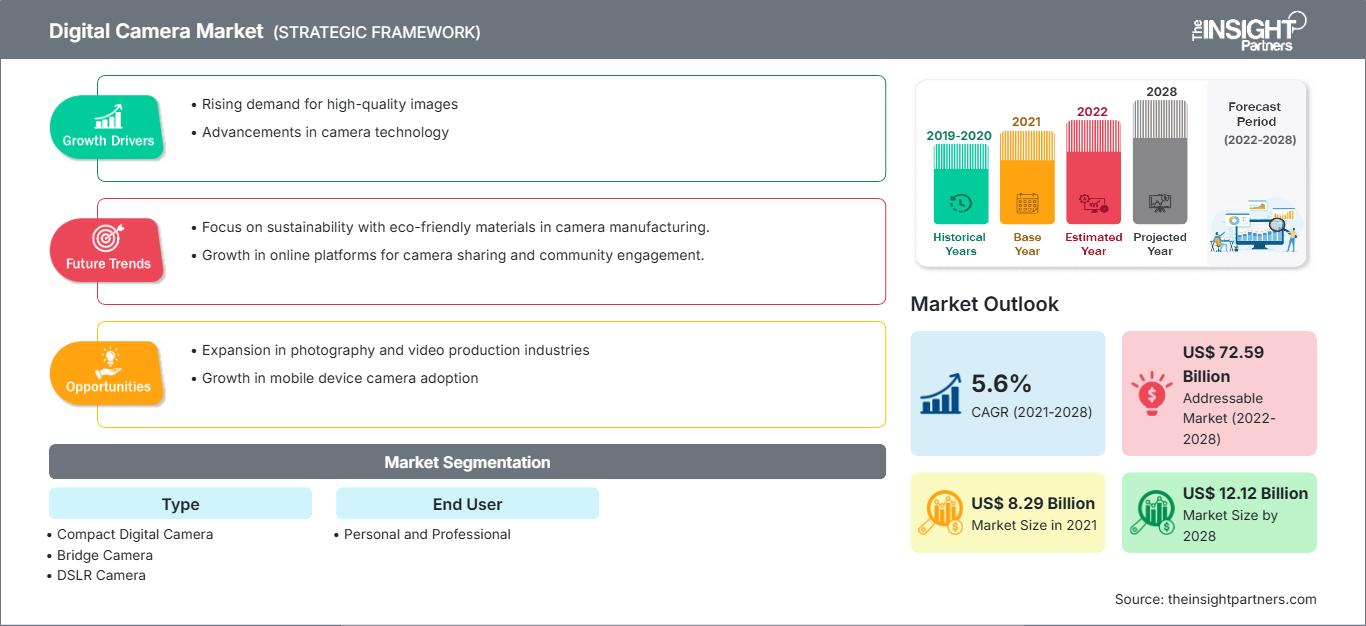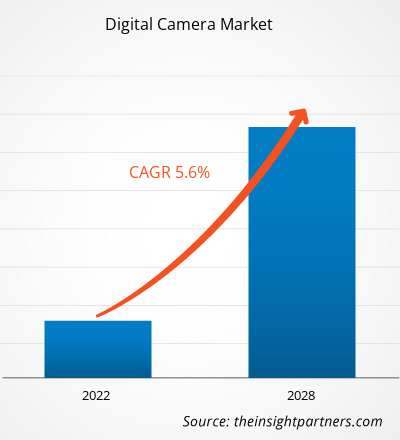预计数码相机市场规模将从 2021 年的 82.9025 亿美元增长到 2028 年的 121.1944 亿美元;预计 2021 年至 2028 年的复合年增长率为 5.6%。
数码相机的用途已不仅限于个人和专业摄影,还扩展到娱乐、媒体和体育行业。电影产业是全球娱乐产业中规模最大、利润最高的类别之一。例如,中国电影产业是全球最大的电影产业之一,2016 年的收入约为 66 亿美元。电影和娱乐产业的良好前景预计将推动对数码相机的需求,以实现完美的拍摄效果和视频质量。快速的技术变革、消费者行为和商业模式已经改变了消费者体验和支付娱乐及媒体内容的方式。该行业的领导者正专注于打造以粉丝为中心的企业和品牌,以制作出优秀的内容。因此,他们在技术和设备上投入了大量资金,例如计算机生成图像 (CGI)、视觉效果 (VFX) 以及先进的摄像机。此外,数码相机在体育媒体中也发挥着不可或缺的作用。在体育场安装高速摄像机和数码相机,可以让观众在关键的比赛时刻观看慢动作回放,并有助于提高观看时的准确性。同样,在野生动物、风景、建筑和影室摄影中使用高分辨率数码相机,有助于获得清晰锐利的图像和视频。人们对动作摄影的日益关注也推动了对 GoPro 等小型数码相机的需求。此外,Instagram 等社交媒体平台也大大扩展了摄影的范围,这反过来又有望促进数码相机市场的增长。
自定义此报告以满足您的要求
您将免费获得任何报告的定制,包括本报告的部分内容,或国家级分析、Excel 数据包,以及为初创企业和大学提供超值优惠和折扣
数码相机市场: 战略洞察

-
获取本报告的主要市场趋势。这个免费样本将包括数据分析,从市场趋势到估计和预测。
由于封锁、旅行禁令和企业倒闭,冠状病毒疫情已影响到各国的经济和各行各业。消费电子行业是受疫情影响最大的行业之一,受到供应链中断、生产工厂停工等严重影响。北美、欧洲、亚太、南美、中东和非洲等主要地区的多家制造工厂的关闭影响了全球供应链,并对各种商品的生产、交付计划和销售产生了负面影响。此外,多家公司已经宣布产品交付可能出现延迟,未来产品销量也可能出现下滑。此外,欧洲、亚洲和北美国家实施的全球旅行禁令也影响了商业合作和伙伴关系机会。预计所有这些因素都将对消费电子行业产生负面影响,从而成为未来几个月该行业相关各个市场增长的制约因素。由于产量不足以及运输设施受限,数码相机市场受到疫情的影响。
数码相机市场洞察 与数码相机相关的技术创新将推动数码相机市场的增长
数码相机市场的框架与新兴的激进趋势密切相关,这些趋势以创新技术发展和强劲进步为后盾,例如高清和触摸屏。长期以来,由于消费者对高级摄影的倾向日益增强,市场对数码单镜头反光相机和单反相机市场的需求不断增加。然而,技术的进步导致了高分辨率相机的诞生,其像素为 1200 万至 2000 万。数码相机领域的不断发展导致了设计出具有更好分辨率、更快对焦速度和对不同外围设备支持的先进相机。此外,人们还观察到在数码相机中加入 Wi-Fi 或 4G 调制解调器的趋势日益增长,以提供相对于智能手机的竞争优势。此外,预计此类相机将成为物联网 (IoT) 等多种互联设备的一部分,从而在不久的将来促进与智能手机和扬声器助手等其他互联设备的有效通信。
基于类型的市场洞察
根据类型,数码相机市场可分为紧凑型数码相机、桥式相机、单反相机、无反光镜相机、数码旁轴相机和线扫描相机。2020 年,单反相机占据了最大的市场份额。
数码相机市场区域洞察
The Insight Partners 的分析师已详尽阐述了预测期内影响数码相机市场的区域趋势和因素。本节还探讨了北美、欧洲、亚太地区、中东和非洲以及南美和中美的数码相机市场细分和地域分布。
数码相机市场报告范围
| 报告属性 | 细节 |
|---|---|
| 市场规模 2021 | US$ 8.29 Billion |
| 市场规模 2028 | US$ 12.12 Billion |
| 全球复合年增长率 (2021 - 2028) | 5.6% |
| 历史数据 | 2019-2020 |
| 预测期 | 2022-2028 |
| 涵盖的领域 |
By 类型
|
| 覆盖地区和国家 |
北美
|
| 市场领导者和主要公司简介 |
|
数码相机市场参与者密度:了解其对业务动态的影响
数码相机市场正在快速增长,这得益于终端用户需求的不断增长,而这些需求的驱动因素包括消费者偏好的不断变化、技术进步以及对产品优势的认知度不断提高。随着需求的增长,企业正在扩展其产品线,不断创新以满足消费者需求,并抓住新兴趋势,从而进一步推动市场增长。

- 获取 数码相机市场 主要参与者概述
基于最终用户的市场洞察
根据应用,数码相机市场分为个人相机市场和专业相机市场。2020 年,专业相机市场占据了更大的市场份额。
数码相机市场的参与者采用合并、收购和市场举措等策略来保持其市场地位。以下列出了一些主要参与者的进展:
- 富士胶片控股公司于 2021 年 2 月下旬宣布推出 FUJIFILM GFX100S。该相机是 GFX 系列无反光镜数码相机的最新成员。
- 尼康公司推出了 Z 7II 全画幅无反光镜相机。Z 7II 是一款全画幅高分辨率无反光镜相机。通过推出此类产品,该公司正在为影像文化的发展做出贡献。
数码相机市场细分如下:
按类型
- 紧凑型数码相机
- 桥式相机
- 单反相机
- 无反光镜相机
- 数码旁轴相机
- 线扫描相机
按最终用户
- 个人
- 专业人士
按地域
-
北美
- 美国
- 加拿大
- 墨西哥
-
欧洲
- 法国
- 德国
- 意大利
- 英国
- 俄罗斯
- 其他地区欧洲
-
亚太地区 (APAC)
- 中国
- 印度
- 韩国
- 日本
- 澳大利亚
- 亚太地区其他地区
-
中东和非洲 (MEA)
- 南非
- 沙特阿拉伯
- 阿联酋
- MEA 其他地区
-
南美洲 (SAM)
- 巴西
- 阿根廷
- SAM 其他地区
公司简介
- 佳能公司
- 伊士曼柯达公司
- 富士胶片控股株式会社
- 徕卡相机股份公司
- 尼康公司
- OM 数码解决方案株式会社
- 松下公司
- 哈苏公司
- 理光映像株式会社
- 索尼公司
- 历史分析(2 年)、基准年、预测(7 年)及复合年增长率
- PEST和SWOT分析
- 市场规模、价值/数量 - 全球、区域、国家
- 行业和竞争格局
- Excel 数据集
近期报告
相关报告
客户评价
购买理由
- 明智的决策
- 了解市场动态
- 竞争分析
- 客户洞察
- 市场预测
- 风险规避
- 战略规划
- 投资论证
- 识别新兴市场
- 优化营销策略
- 提升运营效率
- 顺应监管趋势






















 获取免费样品 - 数码相机市场
获取免费样品 - 数码相机市场